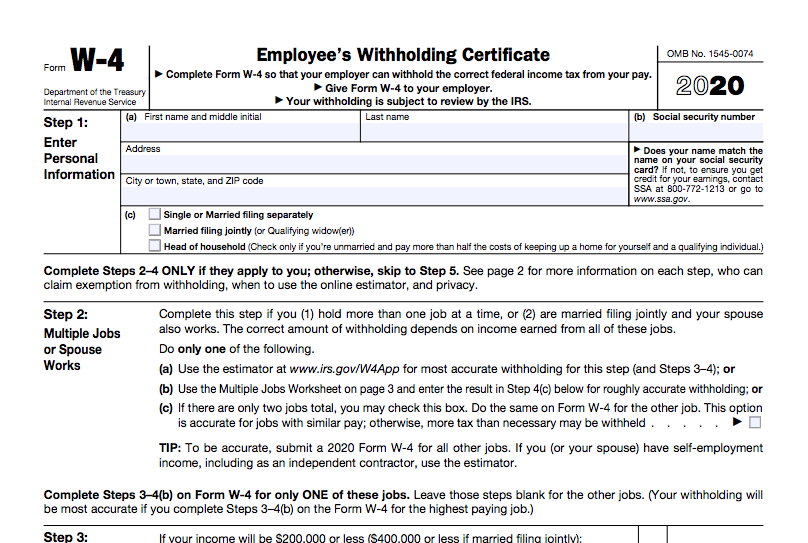Official W-4 2020 Form was released December 5, 2019.
December 8th 9:52Am
On December 5, 2019 the IRS released the official version of the 2020 Form W-4. See below for what these changes include and what they could mean for employers.
Employers: Tax Withholding Assistant Tool
To help small businesses calculate the amount of federal income tax to withhold from their employees, the IRS created the helpful tool: Tax Withholding Estimator.
W-4 Form Changes for 2020 Include:
- A Claim on Dependents. Step 3 of the 2020 W-4 Draft provides an option to claim an allowance of $2,000 per dependent under the age of 17, or $500 for other qualifying dependents if the employee’s income is $200,000 or less ($400,000 or less if married filing separately.)
- An Optional Adjustment Request to Federal Withholding. Step 4 of the 2020 W-4 Draft allows employees to optionally withhold:
A. Interest, dividends, retirement or other nonwage income.
B. Itemized or other deductions for the household, other than the standard deductions.
C. Employee’s determine the amount of federal income they wish to withhold.
3. Another change to this step of the 2020 IRS Form W-4, step 4 does not currently contain the option of entering income from multiple sources of income. Instead, step 2 now instructs employees to use the IRS calculator or the attached worksheets to estimate further withholding requirements. Employees would now enter that amount as “additional amount you want withheld in each pay period” on line C of Step 4.
Employer FAQ about the 2020 W-4 Form
Below are actual Employer Questions to the IRS and the IRS’s Response.
Are new employees that start after Jan 1, 2020 required to fill out the redesigned form?
Yes. All new employees first paid after 2019 must use the redesigned form. Similarly, any other employee who wishes to adjust their withholding must use the redesigned form.
How should we treat new employees beginning employment after 2019 who choose not complete a Form W-4?
New employees first paid after 2019 who fail to furnish a Form W-4 will be treated as a single flier with no other adjustments. (See Full IRS Answer)
Are there computer programs available to help my employees complete the W-4 Form accurately?
Yes. The Tax Withholding Estimator is available at irs.gov/W4app Your employees should consider using the withholding estimator if they:
• expect to work only part of the year (this does not apply if you are only switching jobs),
• had a large balance due or refund last year and it is no longer the beginning of the current year,
• have dividend or capital gain or are subject to additional taxes, such as the additional Medicare tax,
• have self-employment income,
• prefer the most accurate withholding for multiple job situations, or
• prefer to limit information provided in Steps 2-4, but do not want to sacrifice accuracy.
If a current employee paid prior to 2020 wants to adjust withholding from their pay dated January 1, 2020 or later, do they have to fill out the new W-4 Form?
Yes. They must use the redesigned form.
May I ask all of my employees paid before 2020 to furnish new Forms W-4 using the redesigned version of the form?
Yes, you can ask they complete the new form, BUT as part of the request you should explain that:
- they are not required to furnish a new Form W-4, and
- if they do not furnish a new Form W-4, withholding will continue based on a valid form previously furnished. (See Full IRS Answer)
Are all employees required to furnish a new Form W-4?
No. Employees who have furnished Form W-4 in any year before 2020 are not required to furnish a new form merely because of the redesign. Employers will continue to compute withholding based on the information from the employee’s most recently furnished Form W-4. (See Full IRS Answer)
What happened to withholding allowances?
- Allowances are no longer used for the redesigned Form W-4. This change is meant to increase transparency, simplicity, and the accuracy of the form. (See Full IRS Answer)
We keep you compliant.
Keeping you informed on such changes as the IRS W-4 Form Release for 2020 is a small bonus of what our system offers. Our compliance database is built to alert you to the most up to date changes, provide the latest forms, audits, checklists, templates as well as guidance for best HR practices. Our Live HR Advisors are standing by to answer your questions regarding new forms, policy, law and regulation changes. These services and more are available to your company with unlimited use for less than a latte a day.










